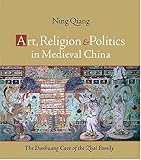Art, Religion, and Politics in Medieval China : The Dunhuang Cave of the Zhai Family / Qiang Ning.
Material type: TextPublisher: Honolulu : University of Hawaii Press, [2004]Copyright date: ©2004Description: 1 online resource (200 p.)Content type:
TextPublisher: Honolulu : University of Hawaii Press, [2004]Copyright date: ©2004Description: 1 online resource (200 p.)Content type: - 9780824827038
- 9780824861490
- 755/.943/095145 22
- N8193.C6 N56 2004eb
- online - DeGruyter
| Item type | Current library | Call number | URL | Status | Notes | Barcode | |
|---|---|---|---|---|---|---|---|
 eBook
eBook
|
Biblioteca "Angelicum" Pont. Univ. S.Tommaso d'Aquino Nuvola online | online - DeGruyter (Browse shelf(Opens below)) | Online access | Not for loan (Accesso limitato) | Accesso per gli utenti autorizzati / Access for authorized users | (dgr)9780824861490 |
Frontmatter -- Contents -- List of Illustrations -- Acknowledgments -- List of Abbreviations -- Map of the Silk Road -- Chronology of the Mogao Caves -- Introduction -- 1. Iconography of the Original Early Tang Paintings: A Reexamination -- 2. Reconstruction: Historical Layers of the Zhai Family Cave -- 3. Historical and Cultural Values of the Zhai Family Cave -- Appendix One. Illustrations of the Bhaiṣajya-guru Sūtra In The Mogao Caves -- Appendix Two. Illustrations of the Western Paradise in the Mogao Caves -- Appendix Three. Illustrations of the Vimalakīrti-nirdeśa Sūtra in the Mogao Caves -- Notes -- List of Chinese Characters -- Works Cited -- Index -- About the Author
restricted access online access with authorization star
http://purl.org/coar/access_right/c_16ec
The cave-temple complex popularly known as the Dunhuang caves is the world’s largest extant repository of Tang Buddhist art. Among the best preserved of the Dunhuang caves is the Zhai Family Cave, built in 642. It is this remarkable cave-temple that forms the focus of Ning Qiang’s cross-disciplinary exploration of the interrelationship of art, religion, and politics during the Tang. The author combines, in his careful examination of the paintings and sculptures found there, the historical study of pictures with the pictorial study of history. By employing this two-fold approach, he is able to refer to textual evidence in interpreting the formal features of the cave temple paintings and to employ visual details to fill in the historical gaps inevitably left by text-oriented scholars. The result is a comprehensive analysis of the visual culture of the period and a vivid description of social life in medieval China. The original Zhai Family Cave pictures were painted over in the tenth century and remained hidden until the early 1940s. Once exposed, the early artwork appeared fresh and colorful in comparison with other Tang paintings at Dunhuang. The relatively fine condition of the Zhai Family Cave is crucial to our understanding of the original pictorial program found there and offers a unique opportunity to investigate the visual details of the original paintings and sculptures in the cave. At the same time, the remaining traces of reconstruction and redecoration provide a new perspective on how, for over three centuries, a wealthy Chinese clan used its familial cave as a political showcase.
Mode of access: Internet via World Wide Web.
In English.
Description based on online resource; title from PDF title page (publisher's Web site, viewed 27. Jan 2023)


